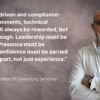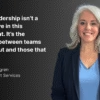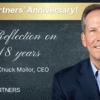Written by Michele Barnett Berg
Through the power of E’³: * Educate * Engage * Empower
Change is no longer an initiative or strategy, but a daily part of being “ the constant shifting of direction, priorities, expectations markets, needs, interests, and environment.
Change is the new normal. Many organizations are realizing that to effectively deal with today’s change and the next inevitable one, they need to be more adaptive about change. In order to do so deliberate actions must be taken to embed change in the organization for sustainability and impact.
Research tells us that most change efforts fail. Change management is outdated. We know that 70% of change programs fail to achieve their goals, largely due to employee resistance and lack of management support, which translates to an ineffective change management strategy and implementation. What does it take to implement change successfully? Our research found that top performing companies are more effective at four practices.
1. Leader Behavior
- Top leaders are effective change managers
- The actions of top management are consistent with the objectives of the change initiative
Based on research, the core behavior of the most effective change managers is modeling behaviors that support the change. In other words, “walk the talk!” If employees perceive that there are two sets of rules and behaviors”one for them and one for senior leaders” the change will lose credibility and be seen as less important. It is not enough to just say the right thing or even enthusiastically communicate the benefits and the business case for the change, as employees want to see those words backed up with behavior. In order to be successful, everyone involved should be “walking the talk”.
2. Goal Clarity
- Clarify the purpose and objectives of the change
- Communicate a clear and appealing vision
In times of change, people look to their leaders for direction and signs that the organization has selected the right course of action. Therefore, it is essential to communicate confidence that the vision can be achieved and that the benefits will be worth the short-term sacrifices. Leaders can convey a message of confidence and optimism through the type of language they use and by consistent actions that demonstrate their conviction and support of the vision.
3. Implementation Planning
- Identify obstacles to implementation
- Identify actions to address those obstacles
Many companies do a lot of work on the front end to put a plan in place that clearly communicates the objectives and prioritizes them so that employees know what they should be doing. They assume that they can subsequently switch on the automatic pilot and employees will stay committed to the plan and carry out the change. Unfortunately, companies that do this will find that they are not achieving their change objectives. Planning, by definition, is working toward an unknown future state. That is why plans should be treated as living documents that are revised as unanticipated problems and opportunities are discovered.
4. Systems
- Ensure adequate systems are available
- Align the performance management system with the change
Organizations need to ensure that they have the proper systems in place to support organizational changes. While leader behaviors are a core component of successful change management, the appropriate structural and systemic factors also need to be in place to reinforce changes. One of the primary tools is the performance management system, which should be viewed as a tool to drive results, rather than an administrative ‘check the boxes’ activity. When goals related to the change effort are integrated into the performance management system and managers are focused on providing coaching and feedback on key behaviors that support the change, it is more likely that the change will be implemented smoothly and stick.
Managing change comes up on almost every list of organizational and leadership success factors. Yet, despite the amount of time and money that has been invested in educating organizations and training leaders in the tools and skills to effectively manage change, most change management efforts don’t work.
As Change Management is the topic du jour for many of our clients, we are supporting them through our recently upgraded Changing Change Management, (CCM) program. CCM provides companies with a structured solution to help its employees thrive not just survive when companies face globalization issues, mergers, acquisitions, new ownership, new leadership, evolving product and service offerings, and/or outsourcing. Advancing the company’s product, scaling innovation, penetrating new markets and handling organization change become insurmountable tasks if and when people are overwhelmed, confused and not aligned and on board to carry out these new change initiatives.
As change is inevitable, we are seeing a significant shift in HR Executives and Leadership taking a more mindful and proactive approach to better prepare their organizations and safeguard their human capital assets by investing in the employees and in all levels of management to be prepared for the speed and intensity of change cycles that they will be experiencing.
Change initiatives are nothing new but how organizations and individuals embrace, manage, and respond to change is definitely being transformed. Companies see that sustainable change happens when its people can on-board the new and still perform their duties and make a valuable contribution. We have responded to the market and to the requests from our clients for programs that educate their people on change as they know this will increase engagement and retention, reduce stress and prevent negative impact on productivity. Our CCM program is based on the premise that all valuable change management programs must include the following components:
E’³ – Educate * Engage * Empower
EDUCATE
What is change theory?
What are change management best practices?
How will I respond to change?
What do I need to do to prepare my people for change?
What are the best practices for managing change?
These are questions we help clients answer as understanding change helps people reflect and gain insights. We introduce clients to change theory, tools and frameworks. Another key insight we have found valuable is understanding how one responds to change by using a behavioral assessment and talent analytics like the Predictive Index® (PI®) which allows us to look at how individuals, teams, and organizations will respond to and deal with change. We understand the importance of knowing ourselves and our reactions, helping us better navigate change and to work most effectively.
ENGAGE
In this part of the program we help leadership, teams and individuals understand how change will affect not only themselves and their organizations, but what the impact will be on the day-to-day. Using frameworks and exercises we analyze these impacts and create action plans to set a constructive course of action to tame the chaos that change can bring.
EMPOWER
Once education has taken place and employees are engaged in the change process we have found that providing support helps embed change more successfully and safeguards motivation, retention and productivity. At this point in the CCM program, one-to-one coaching needs can be identified as well as where future team development support for newly formed teams, or teams that may need to recalibrate. Providing support and empowering employees to enlist coaching where needed helps drive change more successfully.
At MCG Partners, we work with you to individualize a CCM program that will be most effective and successful, focusing on your most important factor in that change, your people.






